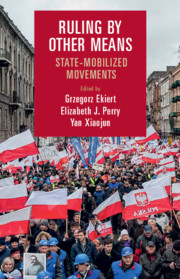Book contents
- Ruling by Other Means
- Cambridge Studies in Contentious Politics
- Ruling by Other Means
- Copyright page
- Contents
- Figures
- Tables
- Contributors
- Acknowledgments
- 1 State-Mobilized Movements: A Research Agenda
- 2 Manufactured Ambiguity
- 3 Suppressing Students in the People’s Republic of China
- 4 State-Mobilized Community Development
- 5 Enforcement Networks and Racial Contention in Civil Rights–Era Mississippi
- 6 Social Sources of Counterrevolution
- 7 Occupy Youth!
- 8 State-Mobilized Movements after Annexation of Crimea
- 9 Mirroring Opposition Threats
- 10 Mobilizing against Change
- 11 The Dynamics of State-Mobilized Movements
- 12 State-Mobilized Campaign and the Prodemocracy Movement in Hong Kong, 2013–2015
- 13 The Resurrection of Lei Feng
- Index
- Books in the Series (continued from p.iii)
- References
2 - Manufactured Ambiguity
Party-State Mobilization Strategy in the March 1968 Crisis in Poland
Published online by Cambridge University Press: 29 July 2020
- Ruling by Other Means
- Cambridge Studies in Contentious Politics
- Ruling by Other Means
- Copyright page
- Contents
- Figures
- Tables
- Contributors
- Acknowledgments
- 1 State-Mobilized Movements: A Research Agenda
- 2 Manufactured Ambiguity
- 3 Suppressing Students in the People’s Republic of China
- 4 State-Mobilized Community Development
- 5 Enforcement Networks and Racial Contention in Civil Rights–Era Mississippi
- 6 Social Sources of Counterrevolution
- 7 Occupy Youth!
- 8 State-Mobilized Movements after Annexation of Crimea
- 9 Mirroring Opposition Threats
- 10 Mobilizing against Change
- 11 The Dynamics of State-Mobilized Movements
- 12 State-Mobilized Campaign and the Prodemocracy Movement in Hong Kong, 2013–2015
- 13 The Resurrection of Lei Feng
- Index
- Books in the Series (continued from p.iii)
- References
Summary
In January 1968, Poland’s communist government banned Dziady, a Romantic play by Adam Mickiewicz, Poland’s national poet, from the stage of the Warsaw National Theater due to its alleged anti-Russian and anti-Soviet undertones. After its last showing on January 30, a couple of hundred students gathered to protest the government’s decision, ending with a demonstration in front of the poet’s monument. The police responded with force, beating the protesters and arresting thirty-five participants. Two students, Adam Michnik and Henryk Szlajfer, were expelled from the University of Warsaw. On March 8, students from UW organized a rally at the university in their defense, expressing their solidarity and condemning the government’s cultural policies. This protest also ended violently – the People’s Militia (Milicja Obywatelska, MO) and plainclothes Voluntary Reserves of People’s Militia (ORMO) dispersed the demonstration and brutally beat up participating students and bystanders.
- Type
- Chapter
- Information
- Ruling by Other MeansState-Mobilized Movements, pp. 24 - 56Publisher: Cambridge University PressPrint publication year: 2020
References
- 1
- Cited by



